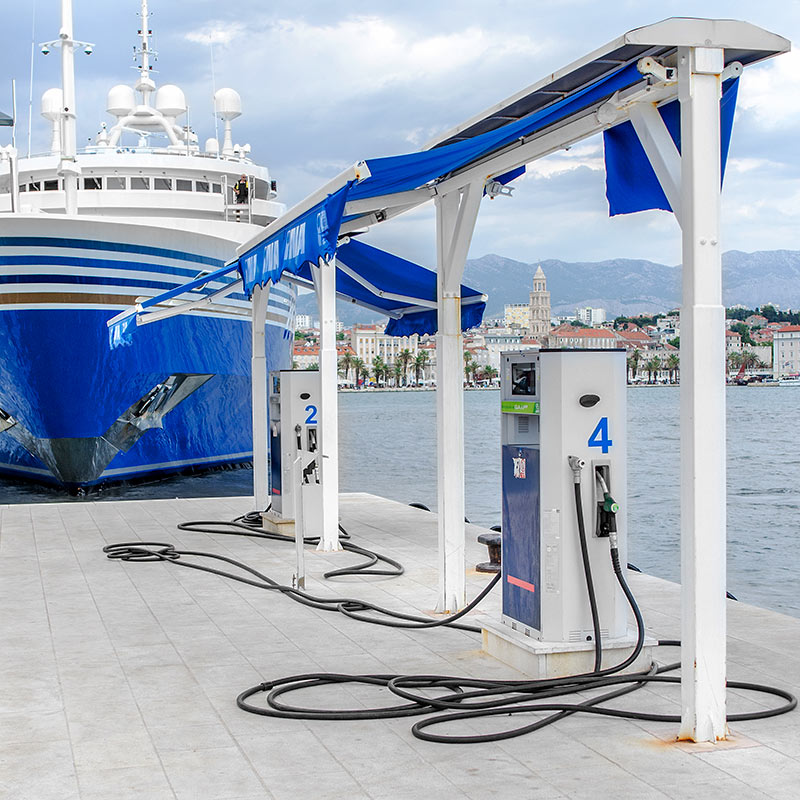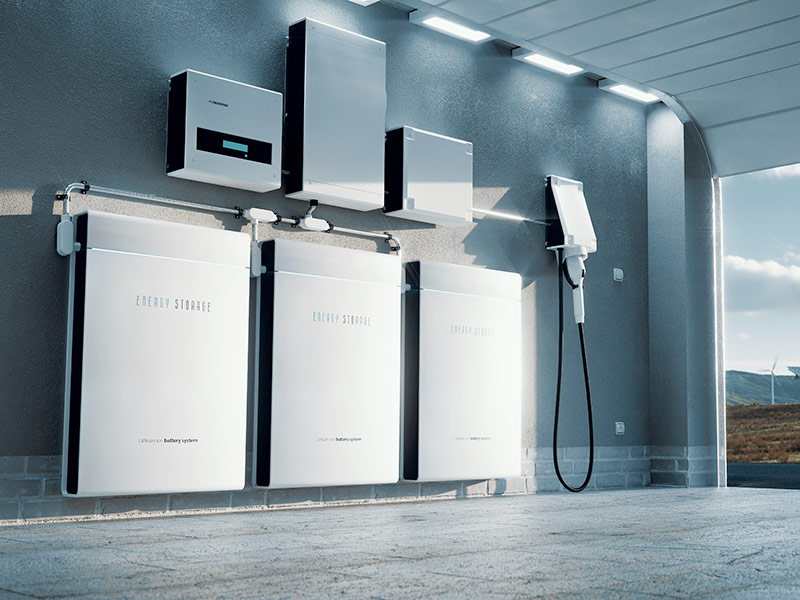
Hydrogen fuel could play an important role in the transition to a net zero economy—particularly for sectors like long-distance transport and heavy industry where emissions reduction is challenging—due to its high energy density and compatibility with existing infrastructure. Producing it sustainably and affordably has historically been difficult. However, recent technological innovations and new public and private investments could make ‘green hydrogen’ significantly more feasible.
What's New
Hydrogen is the most common element on the planet. Its sustainable production for fuel could make a significant impact on reducing transport and manufacturing emissions, as well as help balance the power grid.
As the world responds to the urgency of the climate crisis, certain sectors—like transport (including trucking, shipping, and aviation) and manufacturing (including steel, cement, and plastics)—cannot easily shift to electrification to reduce emissions. Green hydrogen presents a viable pathway to decarbonization for these hard-to-abate sectors, given its high energy density and compatibility with existing infrastructure.
Until now, the only economic way to produce hydrogen has been steam reforming—a process of reacting methane with steam under high pressure—which also generates significant carbon pollution. However, when hydrogen is produced through electrolysis—the process of splitting water into hydrogen and oxygen—and it is powered by renewable energy, the result is ‘green’ hydrogen and the only byproduct is water.
Green hydrogen production is now becoming more economical due to public and private investment as well as technological innovation—including advances in electrolyzer performance and efficiency.
At the same time, significant amounts of excess renewable electricity have become available at grid scale as a result of the proliferation and reduced cost of solar, wind, and other renewable energy sources. Therefore, rather than storing excess electricity in arrays of utility-scale batteries, which present challenges due to cost, durability, material sourcing and end-of-life recycling, the extra electricity can be used to drive the electrolysis of water, thus storing the electricity in the form of hydrogen.
Because of its ability to store energy produced from renewable sources, green hydrogen can help balance out the power grid and address intermittency issues. In addition, it enables the export of energy from renewable-rich areas to locations with fewer renewable energy generation resources.
The most exciting initiatives are those that take a systemic approach, where excess renewable energy can be used to produce hydrogen in a way that both balances the grid and helps decarbonize hard-to-abate sectors. Falling costs for hydrogen produced with renewable energy, combined with the urgency of cutting greenhouse-gas emissions, has given green hydrogen new political and business momentum. Because of this, green hydrogen has emerged as an important part of the clean energy mix needed to ensure a sustainable future.
Signals of Change
Developers across the world are for the first time testing the use of hydrogen to power ships. Companies are working on a variety of hydrogen-fueled ships, including a river vessel along France’s Rhone, a Norwegian support ship for the offshore oil sector, a passenger shuttle boat and a tug boat project in Belgium, and Asia’s first hydrogen ferry, which will launch in Japan in April 2021. These will all help to achieve the maritime industry’s goal of having net zero ships enter the global fleet by 2030.
In November 2020, energy companies BP and Orsted signed a letter of intent to work together on a major renewable hydrogen project in Germany. The development of a large-scale renewable hydrogen project for a refinery in Europe is the latest example of major businesses in the energy sector focusing on “green hydrogen” for heavy industry facilities. The fuel is to be produced from energy generated by an offshore wind farm in the North Sea.
In July 2020, Microsoft announced that hydrogen fuel cells powered a row of data center servers for 48 consecutive hours. This is the first time hydrogen has been used to power data centers for 48 continuous hours and shows an alternative to diesel backup generators. A key technology component, a PEM electrolyzer, has dropped in cost by 75 percent since it was tested in 2018, which could make the capital costs of fuel cell generators price competitive with diesel generators in one or two years. Microsoft imagines also integrating the technology with the electric power grid to provide load balancing services.
Fast Forward to 2025
The transformation of inland waterways by green hydrogen-powered vessels in Europe in recent years has been impressive. The canals and other rivers were largely in disrepair, but a renaissance took place...
The Fast
Forward
BSR Sustainable Futures Lab
Business Implications
Green hydrogen is expected to play a key role in the decarbonization of hard-to-abate sectors, such as shipping and manufacturing, that require fuel that is high in energy density with long-term reliability.
Heavy-duty and long-range transport and energy-intensive industrial processes will likely continue to rely on combustible fuels, which contribute to climate change, for various purposes in the near future as the technology and infrastructure for green hydrogen are not yet in place.
In this context, operational changes needed for business to adopt green hydrogen include the readjustment from having a go-to fuel for any application, such as fossil fuels, natural gas, or diesel, to having to contend and strategize around a “poly fuel” future in which green hydrogen is one of many fuel options. In this future, businesses will need to either retrofit existing assets to run on hydrogen or replace with new assets.
Over the medium-term, hydrogen may be blended with natural gas or fossil fuels to increase the efficiency of the burn, reducing carbon and potentially cost. Investing in renewable energy projects could also become more profitable, as these sources can be used to create green hydrogen.
The need for new supply infrastructure could limit hydrogen use to countries adopting this strategy, although natural gas infrastructure has been identified as an asset that can be reused for green hydrogen distribution. It can be retrofitted to enable the distribution of hydrogen, easing the energy transition because of leveraging what could otherwise be a stranded asset. In this context, the legal and contractual framework needs to be clear for businesses to enter green hydrogen with clear expectations about its impact to the bottom line.
Sustainability Implications
A hydrogen-based energy transition will not happen in a broad sense in the short term. Hydrogen use is only likely to catch on for specific target applications or industries at first. Companies can work with shipping partners and government affairs teams to advocate for policies that enable widespread adoption of green hydrogen and investment in related infrastructure.
The most important implication for sustainability teams is that green hydrogen provides an opportunity to reduce emissions from hard-to-abate sectors. This includes opportunities for reductions in carbon dioxide emissions from fossil fuel burn and fugitive methane emissions, reduction in particulate air emissions, volatile organic compounds (VOCs), ozone, and other emissions associated with transport, and reduced impacts of transit corridors on marginalized communities.
Green hydrogen might, by 2050, cost between 70 cents and $1.6 a kilogram—in other words the current price of the grey variety.
A second implication for businesses is that green hydrogen can help with grid storage, which would enable renewables to scale up to meet peak demand. The storage potential of hydrogen is particularly beneficial for power grids, as hydrogen allows renewable energy to be kept not only in large quantities but also for long periods. This can create sustainable business opportunities.
Business strategic planning needs to recognize nevertheless that green hydrogen will cost more over the short term compared to existing fuels, although in the long term, it can become cost competitive. The question of who will bear the burden of these costs is not clear and could impact businesses in production or transport sectors, or costs can be also passed on to the consumer.
The goal of making sure that this process leaves no one behind will also be an important consideration for busines leaders and sustainability teams as they embark in the process to adopt green hydrogen. As with the adoption of other renewable energy uses, businesses should consider how to create a just transition from fossil fuels to renewables as the impacts on jobs and communities will be significant.
In addition, companies should also be aware green hydrogen is being pursued at small, individual-use scale, and could have some advantages to increase renewable-energy access, including to places outside the reach of power grids. Green hydrogen is also a sustainable business opportunity for businesses in countries or regions that have not historically produced fuels and are starting to invest in their production and create new business opportunities.
![]()
Previous issue:
Technology Gets Emotional
![]()
Next issue:
AI in Hiring
































